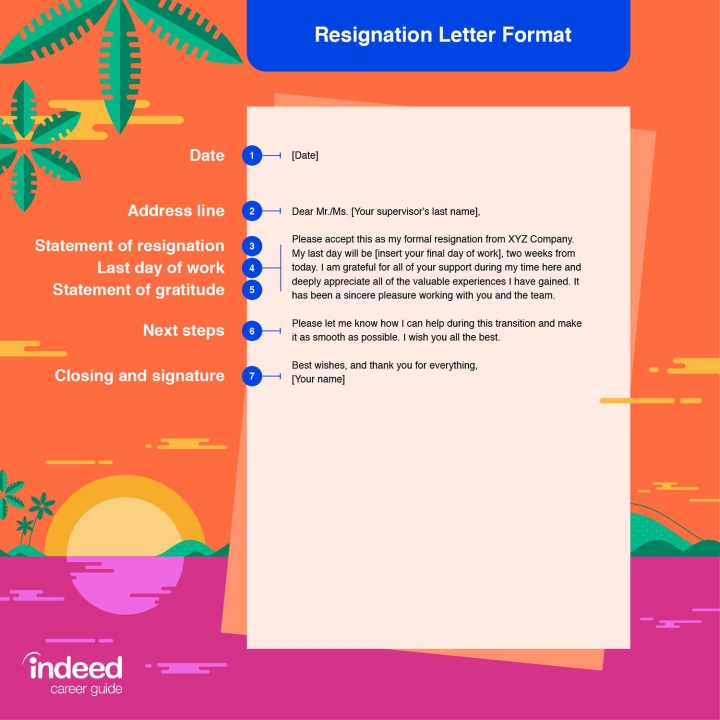To write a short resignation letter, state your intention to resign and include your last working day. Keep it polite and professional.
Writing a short resignation letter can seem daunting, but it doesn’t have to be complicated. A concise resignation letter clearly communicates your departure while maintaining a positive tone. It’s important to be direct yet courteous to leave a lasting good impression.
Start by stating your intention to resign and the effective date. Express gratitude for the opportunities you had during your tenure. This approach keeps the letter professional and respectful, ensuring a smooth transition. Following these guidelines can help you craft a resignation letter that is both succinct and effective.
:max_bytes(150000):strip_icc()/short-notice-resignation-letter-2063520-FINAL2-edit-49a6089de1804d9e9fdd2be097494e6b.jpg)
Credit: www.thebalancemoney.com
Reasons For A Short Resignation Letter
Sometimes, personal reasons make it necessary to leave a job quickly. Family emergencies or health issues can demand immediate attention. In such cases, a short resignation letter is appropriate. A brief letter helps to convey your message without going into details. This way, your employer understands your urgency and respects your privacy.
Keeping the resignation letter short shows respect for your employer’s time. A concise letter is easy to read and process. It also shows your professionalism. Short letters can still express gratitude and appreciation for the opportunities given. This maintains a positive relationship even after your departure.
Key Elements To Include
Start with a simple sentence. State your intention to resign. Be direct and to the point. This helps avoid confusion. Example: “I am resigning from my position at [Company Name].”
Mention your last working day. Ensure it follows the company policy. This helps your employer plan. Example: “My last working day will be [Date].”
Thank your employer for the opportunities and experiences. Show gratitude. This leaves a positive impression. Example: “Thank you for the opportunities and experiences at [Company Name].”
Choosing The Right Tone
Always keep a professional tone in your resignation letter. Respect your employer and workplace. This shows you value the time spent there. Avoid any negative comments or complaints. Gratitude is key. Mention your appreciation for the opportunities given. This leaves a positive impression.
Maintain a positive tone throughout your letter. Highlight the good experiences and skills you gained. This helps in keeping good relationships. Thank your employer for their support. Focus on the future and your personal growth. A positive tone makes your resignation smoother.
Formatting Tips
A short resignation letter should be brief. Include only essential details. Start with a polite greeting. State your intention to resign. Mention your last working day. You can offer to help during the transition. End with a thank you.
Use formal language at all times. Avoid slang or casual words. Always address your boss by their title. Use phrases like “I am resigning” and “My last day will be”. Politeness is key. Thank your employer for the opportunities.
Common Mistakes To Avoid
Many people make mistakes by being too emotional or overly detailed in their short resignation letters. Keep the tone professional and concise, focusing on key points like your resignation date and gratitude.
Negative Comments
Always stay positive. Never write negative comments in a resignation letter. It can hurt your professional image. Speak kindly of your time at the company. Focus on the positives. Leave on good terms.
Incomplete Information
Provide all necessary details. Include your last working day. Mention your job title and department. Add a brief thank you note. This helps in a smooth transition. It shows professionalism.

Credit: www.indeed.com
Sample Resignation Letters
I am resigning from my position at [Company Name]. My last day will be [Date]. Thank you for the opportunity to work here. I have learned a lot during my time at this company. I wish the team all the best.
I am resigning from my role at [Company Name]. My last working day will be [Date]. I am grateful for the support and guidance you provided. Working here has been a great experience. I appreciate the opportunities I have had. Thank you for everything.
Submitting Your Resignation
Choose the best way to deliver your resignation letter. Email is quick and efficient. Hand-delivering the letter adds a personal touch. Mailing the letter is also an option. Each method has its own benefits. Think about the relationship with your boss. Choose the method that feels right.
Timing is crucial when resigning. Give at least two weeks’ notice. This shows respect and professionalism. Plan the resignation around your workload. Avoid busy periods if possible. The right timing helps with a smooth transition.

Credit: jobsandcareer.tips
Handling The Exit Process
Planning your transition is crucial. Create a list of current projects and tasks. Include all deadlines and important details. Share this list with your manager and team. Assign responsibilities to team members. This helps ensure a smooth handover. Document key procedures and workflows. Keep everything clear and easy to understand. This will help your replacement take over quickly.
Prepare for your exit interview by listing your achievements. Highlight your contributions to the company. Think about feedback you can give. Be honest but respectful. Mention areas for improvement. This can help the company grow. Practice answering common questions. Stay calm and positive during the interview. This leaves a good last impression.
Conclusion
Crafting a short resignation letter can be straightforward. Follow these tips for a smooth transition. Use clear language and maintain professionalism. Refer to our samples for guidance. Remember, your resignation letter reflects your professionalism. Good luck with your next career step!
